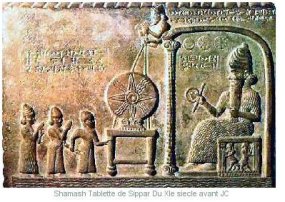Text
The Sun disk on the relief of Nabû-apla-iddina (9th century BCE) is paralleled by Harranian hanging sun emblem.
Ibn Waḥshīya, Nabatean Agriculture 296:
Further, they (the Harranians) claimed that all the idols came from all regions to Bayt al-ˀŠKWL in Bābil and all went to the temple (haykal) of the Sun, and especially to the great golden idol which hangs between heaven and earth. The idol of the Sun stood in the middle of the temple and all the world’s idols stood around him.
Maimonides, Guide for the Perplexed 3.29:
(All the statues of the Sabians of Harran) des différentes contrées de la terre se réuninerent dans la temple de Babylone, auprès de la grande statue d’or, qui est celle de soleil. Cette statue, qui était suspendue entre le ciel et la terre, tomba au milieu du temple et toutes les autres statues se placèrent autour d’elle.
Philostratus, Life of Apollonius of Tyana 1.25:
They say that they also visited men’s quarters (in the palace of Babylon) with a doomed roof imitating a kind of sky, roofed with sapphire. This stone is very blue and heavenly to look at. Images of the gods whom the Persians worship were set up on high and looked golden, as if they were in the upper air. This is where the king sits in judgement, and four golden wrynecks (iynges) hang from the ceiling, reminding him of Adrasteia (= Nemesis) and that he must not elevate himself above the human. The Magi say that they themselves hang these up when they visit the palace, calling them “the tongues of the gods”.
Sources (list of abbreviations) (source links will open in a new browser window)
Ibn Waḥshīya, Nabatean Agriculture 296
Maimonides, Guide for the Perplexed 3.29
Philostratus, Life of Apollonius of Tyana 1.25
Bibliography
| Hämeen-Anttila 2002, 97 | Hämeen-Anttila, Jaakko. “Continuity of Pagan Religious Traditions in Tenth-Century Iraq.” In: A. Panaino and G. Pettinato (eds.). Ideologies as Intercultural Phenomena. Melammu Symposia 3. Milan: Universita di Bologna & IsIAO 2002, 89-108. [PDF] |
| Jones 2005, 98-99 | Jones, Ch. P. Philostratus, The Life of Apollonius of Tyana. Cambridge MA: Harvard University Press 2005. |
| Reiner 1996, 312 | Reiner, Erica. “Suspendu entre ciel et terre...” In: H. Gasche and B. Hrouda (eds.). Collectanea Orientalia. Histoire, arts de l'espace et industrie de la terre. Etudes offertes en hommage à Agnès Spyket. Civilisations du Proche-Orient 3, Série I. Neuchâtel: Recherches et Publications 1996, 311-313. |
Amar Annus
URL for this entry: http://www.aakkl.helsinki.fi/melammu/database/gen_html/a0001131.php
|

